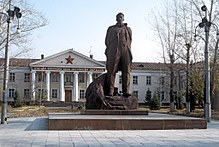Semipalatinsk nuclear weapons test site
The Semipalatinsk Test Site ( Russian Семипалатинский ядерный полигон Semipalatinski Jaderný poligon , Kazakh Семей полигоны Semipalatinsk poligony ) is a former nuclear test site of the Soviet Union and is located in Kazakhstan .
Location and climate
The Semipalatinsk nuclear weapons test site is located approx. 400 km east of the capital Nur-Sultan (Astana until 2019) , west-southwest of the city of Semei (Russian Semipalatinsk ) in the Kazakh steppe at an altitude of 100 to 300 m with mountain ranges of up to 1200 m. Due to the continental location, there are large differences between summer (up to 45 ° C) and winter temperatures (down to −50 ° C) with a low annual rainfall of 200 to 300 mm.
History of the proving ground

While the United States carried out the first nuclear weapon test on the Alamogordo Test Range in New Mexico state before the atomic bombs were dropped on Hiroshima and Nagasaki in 1945 , the Soviet Union moved four years later, on August 29, 1949, with the explosion of the RDS-1 to. The main test area was the Semipalatinsk nuclear weapons test site near the city of Kurchatov in what is now Kazakhstan , where the administration of the nuclear weapons test site was located. From 1949 to 1989, 496 nuclear bomb tests were carried out here, mainly for military purposes.
The test site in the Kazakh steppe about 800 km north of Almaty was difficult to access and was considered top secret. To a total of approximately 18,000 km 2 in 1962 explosions in the atmosphere or on the ground of the terrain found in a first phase by the year mainly in the northern part instead, which led to a significant radiation dose to the atmosphere. From 1963, tests were carried out on the site in boreholes and tunnels in the Balaplan area and in the Degelen mountains.
On August 29, 1991, the Semipalatinsk nuclear weapons test site was closed, and in 1996 the tunnels were sealed, but they were opened up again by illegal scrap metal dealers.
With 100 tons of TNT , the last tunnel on the site was collapsed on July 29, 2000 and the previous nuclear use of the area was finally ended. In 2012, the securing of all known remains of the nuclear tests was completed.
The proving ground today
The former nuclear weapons test site is still a restricted area today, but it is practically accessible to everyone. The tunnels and tunnels that were built and mostly used for testing atomic bombs are now filled and closed. 496 nuclear weapons were detonated, 113 above and 383 underground. This corresponds roughly to the explosive power of 2500 Hiroshima bombs. Today, 20 years after the last blast, the radiation is about 400 times higher than the recommended maximum value.
Most of the residents of the neighboring areas suffer from various diseases, mainly cancer . Since it is time-consuming and expensive to provide the evidence required by the authorities for each individual case that the nuclear tests are causally related to the diseases, most of those affected are not recognized as victims and live in the poorest of conditions. Today's use takes place partly in the form of extensive pasture farming (horses, goats). In the southeast part of the site, coal is also mined in open-cast mines.
Due to the historical use of the site for nuclear tests, the Treaty of Semei was signed on September 8, 2006 in the nearby city , which declared Central Asia a nuclear weapons-free zone. The treaty was ratified by all five signatory states in 2009 and is therefore in force.
The Jülich Research Center supported the Institute for Nuclear Physics of the National Nuclear Center of the Republic of Kazakhstan in the monitoring of groundwater .
In 1997, the USA and Kazakhstan agreed to store the fuel elements from the Kazakh nuclear power plant in Aqtau in specially developed containers on the area of the former Semipalatinsk nuclear weapons test site. In 2007 the transfer to Semipalatinsk was completed.
literature
- Eben Harrell, David E. Hoffman: Plutonium Mountain: Inside the 17-Year Mission to Secure a Legacy of Soviet Nuclear Testing , Belfer Center for Science and International Affairs, Harvard Kennedy School, 2013.
Web links
- IAEA ( International Atomic Energy Agency ) for activities on the test site: ns.iaea.org
- Kazakh Nuclear Research Center ( National Nuclear Center ), sts.nnc.kz: Current status (Russian) and history (English)
- Deutschlandfunk , Das Feature , September 10, 2013, Ulla Lachauer: dradio.de: Steppe quake - eyewitnesses of the Soviet nuclear weapons tests tell (September 12, 2013)
Individual evidence
- ↑ Marcus Bensmann: Cows at the atomic lake. taz.de, December 3, 2013
- ↑ a b Securing fissile material: Secret operation on the plutonium mountain . In: Neue Zürcher Zeitung , August 19, 2013.
- ↑ Augsburger Allgemeine from July 29, 2010, column: The date
- ↑ n-tv.de: series of images: History of the nuclear tests , requested on September 2, 2010
- ↑ a b extra, The RTL magazine from October 26, 2009
- ↑ Groundwater monitoring on the Semipalatinsk Test Site STS ( Memento from July 27, 2012 in the Internet Archive ), Forschungszentrum Jülich
- ↑ Brief report on groundwater monitoring on the nuclear weapons test site (pp. 3–6–3-8) in the 2006 annual report of the Safety and Radiation Protection division (Forschungszentrum Jülich) ; Focus: Degelen Mountains, Balapan Area; with maps, geol. Profile, chem. Analyzes
- ↑ nti.org - Securing the Bomb: Securing Nuclear Warheads and Materials BN-350 Spent Fuel Security ( Memento of March 8, 2008 in the Internet Archive ) (English)
Coordinates: 50 ° 7 ′ 0 ″ N , 78 ° 43 ′ 0 ″ E


